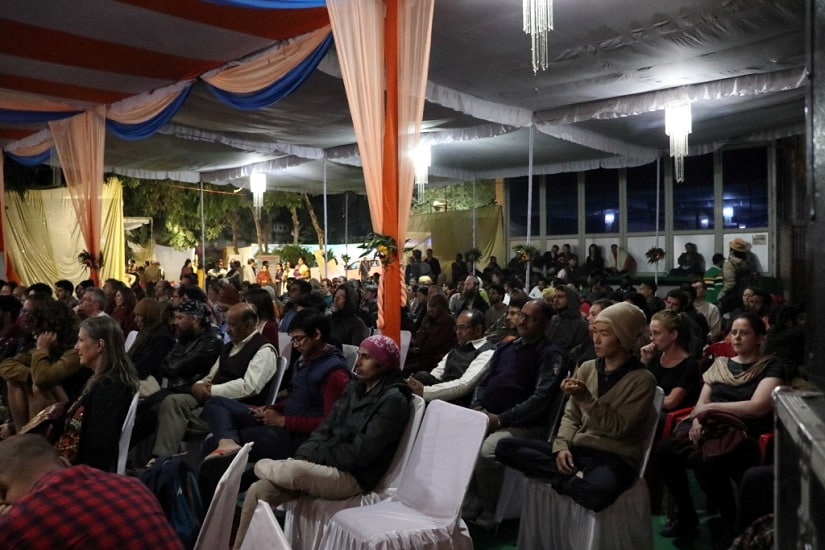Dhrupad Mela in Tusli Ghat Varanasi
During my trips to Ramnagar for the Ramleela I came across people who refer to the performance as "Mela" — a celebration of the epic. On similar lines, the music festival organised under the auspices of the Banaras Vidya Mandir Nyas, and now in its 45th year, is known as the ‘Dhrupad Mela’ — a celebration of Dhrupad. Where else to celebrate the oldest existing form of north Indian classical music but in one of the oldest cities in the world?
The entry, like at most music events in town, is free; the setting is simple, and the artists and connoisseurs mingle (away from the stage) after performances. The absence of concert practices influenced by the West (read: a formal, dry atmosphere) is conspicuous. In 2018, Shailaja Khanna wrote of the Dhrupad Mela: ‘It is not merely a festival of music, but a mela involving more than just music concerts’. A contrarian view was expressed in 2015 by Nandini Majumdar, who wrote, ‘The Dhrupad Mela remains (above all)... a mela or fair, which people ... seem to visit for entertainment’. Perhaps it is to distance sentiments like these that Ustad Wasifuddin Dagar — who performed on the second evening of the festival this year — said that he preferred to call the event the 'Dhrupad Samaroh' as opposed to Mela.
Ustad Wasifuddin Dagar’s performance was exquisite. That same evening (2 March) featured a total of 13 performances. Three lists were put up bearing artist names — one for pakhawaj, another for other instruments, and the final list for vocals. Each of these boasted local artists as well: Ankit Parikh (pakhawaj), Deobrat Mishra (surbahar), Prof Ritwik Sanyal (vocals) among them. A simple A4 paper carrying a list was also put up each evening in a corner. It mentioned the artists' names, in order of their performances, for that particular evening. In sync with the ambience of the festival, the schedule mentioned only the start time — 7 pm.
Performances went on well after sunrise. One of the organising team members I had a brief conversation with, shared that he went from the Dhrupad Mela to the Subah E Banaras straight away. (Subah E Banaras is the cultural programme organised at Assi Ghat each morning. Assi Ghat abuts Tulsi Ghat — the location of the Dhrupad Mela.) Its location is an aspect of the Dhrupad Mela that is difficult to match. A few steps from the chairs for the audience is was a terrace overlooking the river. Some prefer to savour the music from here. As I faced the river, I could see the Assi Ghat to my immediate right and the Dufferin (Rajghat) bridge to my far left. Straight ahead, lay darkness. I was then reminded of Aatish Taseer’s eloquent description of this darkness, but for now I move on.
On the third evening I saw people on the ghat below, walking in large numbers — as if a huge tap had opened up and human beings flowed out in lieu of water. They were undertaking the annual pilgrimage, Panch Koshi Yatra — a 75-km walk. A different world, a different people. It rained that evening. The lights went off for a brief period, but the performance continued.
That evening I also caught Akhtarbhai alone. I had noticed his stall last year as well, with tanpuras on display. Akhtarbhai has been attending the Dhrupad Mela for the past 20 years; it is the only music event he attends regularly. This year his son accompanied him as well and they had got the tanpuras along, in the train. Their’s is one of the approximately 50 families in Miraj (Sangli, Maharashtra) making tanpuras. They make other string instruments as well. Akhtarbhai shared that the gourds for the tanpuras came from Pandharpur. When I asked him where he put up during his trips to Varanasi, he smiled, and said Rewa Kothi. This palace, donated to Banaras Hindu University, is currently used as a hostel for students of performing and visual arts. During their stay, Akhtarbhai and his son also repaired the tanpuras of these students.
The fourth and final day of the Dhrupad Mela had 11 performers including some from Austria, Kathmandu and France. This year also saw an increase in the number of young female performers. Pandit Bhajan Sopori stated that innovation was crucial in music as he set the santoor; the audience sat in attentive silence during the performance, which ended with a "Har Har Mahadev". His performance made me dwell on how the same instrument can sound so different, in different hands.
It does not have the tag of "the biggest" or "the music festival in town" because the town is only Varanasi. And it is a testimony to Varanasi’s identity as India's cultural capital that the day Dhrupad Mela had its final set of performances, less than half-an-hour’s walk away, another event — the three-day Shivratri Sangeet Mahotsav — had its first.
Enquiry Now



